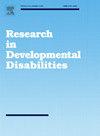有脊柱裂儿童的家庭的离婚风险和生育额外孩子的可能性:瑞典一项基于人群的纵向登记研究
IF 2.9
2区 医学
Q1 EDUCATION, SPECIAL
引用次数: 0
摘要
抚养残疾儿童可能会带来挑战,并影响家庭的运作。在这项研究中,分析了脊柱裂儿童父母离婚的风险和生育额外孩子的可能性。方法采用间隔筛选的Cox比例风险模型,对2004 - 2014年多个瑞典人口登记的纵向匹配病例对照数据进行分析。结果:与没有脊柱裂的孩子的父母相比,患有脊柱裂的孩子的父母离婚的风险降低。注意到一些异质效应的迹象;与同居、受教育程度较高、母亲年龄较大(34 +岁)的父母相比,已婚父母对脊柱裂的保护作用更强。没有发现有脊柱裂的孩子出生后有额外的孩子。研究结果应该放在瑞典的背景下理解,瑞典以其全面的福利制度而闻名。未来的研究应该调查这些结果背后的机制。这篇文章补充了什么?本研究利用基于人群的登记数据,为该领域做出了贡献,这在脊柱裂研究中是罕见的。与先前的研究比较表明,残疾之间存在很大的异质性,这表明虽然一些研究可以在广泛的残疾水平上进行,但在某些情况下,将残疾作为一个群体进行研究或将结果从一种残疾推广到另一种残疾可能是不合适的。本文章由计算机程序翻译,如有差异,请以英文原文为准。
Risk of divorce and likelihood of having additional children among families with children with spina bifida: A Swedish population-based longitudinal register study
Background
To raise a child with disability might present challenges and affect the functioning of the family unit. In this study, the risk of divorce for parents of children with spina bifida and the probability of having additional children were analysed.
Methods
Longitudinal, matched case-control, data between 2004 and 2014 from multiple linked Swedish Population Registers were analysed using Cox proportional hazard models with interval censoring.
Results
The results showed a reduced risk of divorce among parents of children with spina bifida compared to parents of children who did not have spina bifida. Some indications of heterogeneous effects were noted; a stronger protective association was noted among parents who are married compared to cohabiting, have higher education, and where the mother is older at the birth of the child with spina bifida (34 + years). No association was found on having additional children after the birth of a child with spina bifida.
Conclusion
The results should be understood in the Swedish context, which is known for its comprehensive welfare system. Future research should investigate the mechanisms behind these results.
What this paper adds?
This study contributes to the field by utilizing population-based register data, which is rare for spina bifida research. Comparison to prior studies indicates that there is substantial heterogeneity across disabilities indicating that while some research can be conducted at the broad disability level, in certain contexts it might be inappropriate to study disability as a group or generalising the results from one disability to the next.
求助全文
通过发布文献求助,成功后即可免费获取论文全文。
去求助
来源期刊

Research in Developmental Disabilities
Multiple-
CiteScore
5.50
自引率
6.50%
发文量
178
期刊介绍:
Research In Developmental Disabilities is aimed at publishing original research of an interdisciplinary nature that has a direct bearing on the remediation of problems associated with developmental disabilities. Manuscripts will be solicited throughout the world. Articles will be primarily empirical studies, although an occasional position paper or review will be accepted. The aim of the journal will be to publish articles on all aspects of research with the developmentally disabled, with any methodologically sound approach being acceptable.
 求助内容:
求助内容: 应助结果提醒方式:
应助结果提醒方式:


